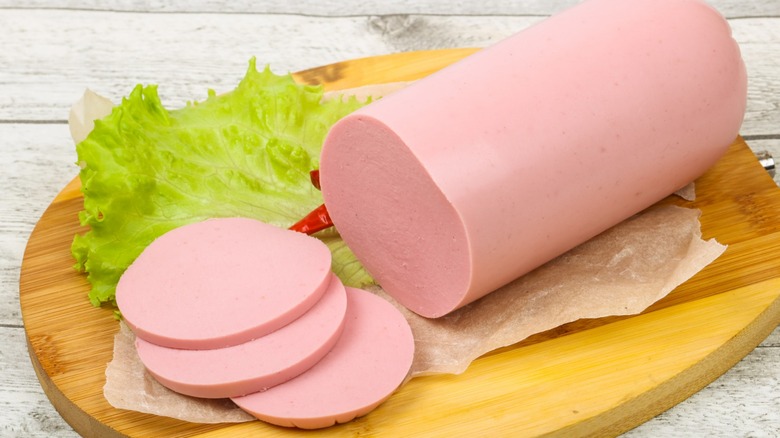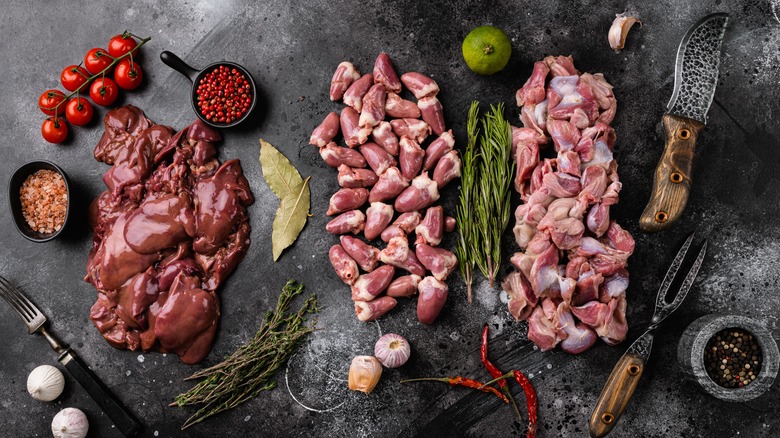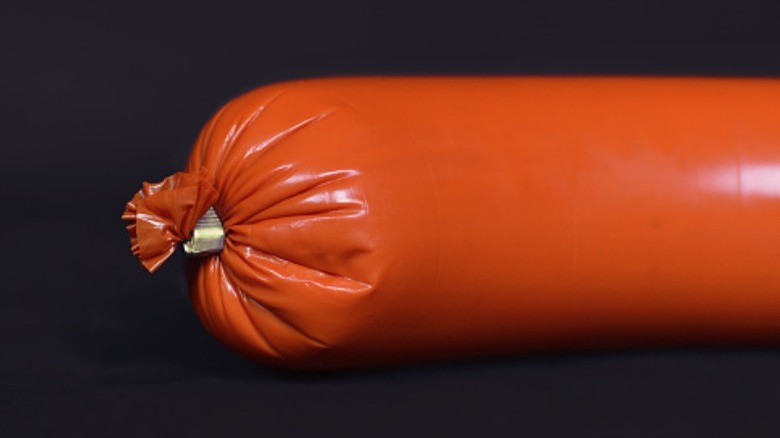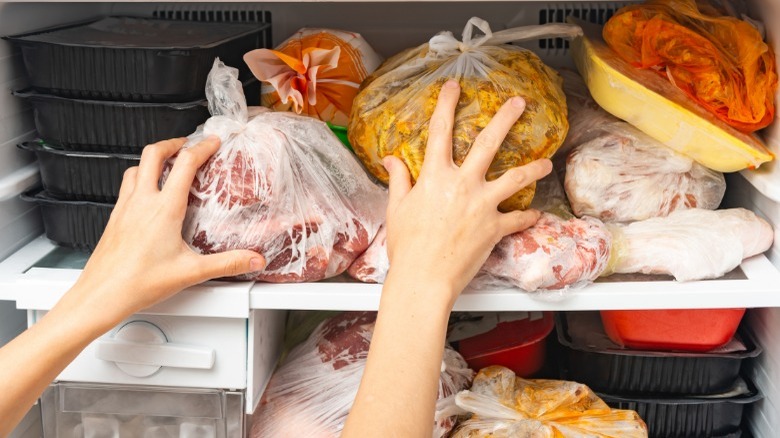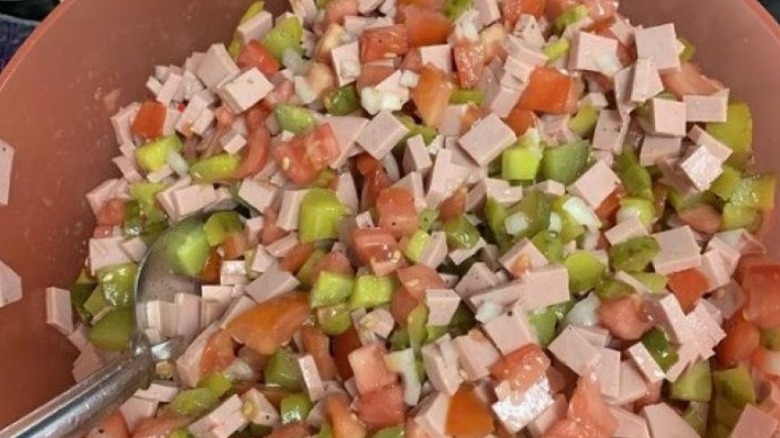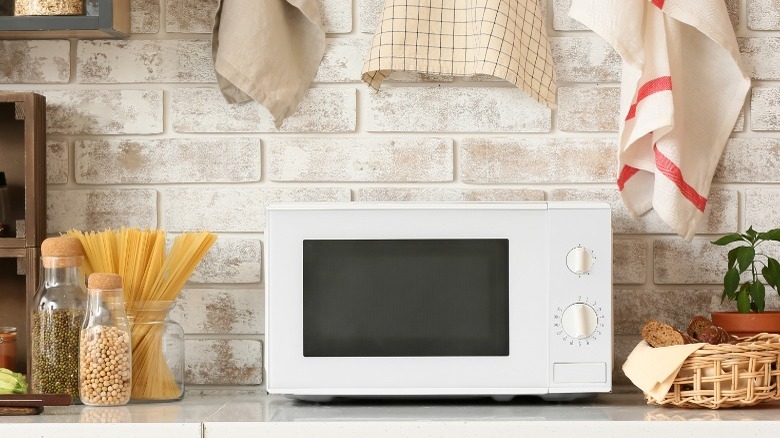The 12 Bologna Mistakes You're Probably Still Making
You might see humble bologna packages in your grocery store's refrigerated deli section or notice it in the deli case and choose to ignore it. Perhaps you buy it once in a while, but only use it to make boring, basic sandwiches. Maybe you even end up throwing it away because it has gone bad.
Why does bologna have such a sad reputation? And just as importantly, what is it made from?
The USDA classifies bologna under the frankfurters category, which also includes hot dogs. Technically, bologna is cooked or smoked sausages, made from one or more kinds of ground-up raw or cooked meats. This can include beef, pork, or poultry, all combined with curing ingredients and water. These mixtures are formed into different-sized links.
GQ's Juan Vidal explains that people might associate bologna and other foods like Spam with being deprived of better food; the packaging and smells can also be turn-offs. The price doesn't help improve its reputation either: You can order a pound of packaged Oscar Mayer Bologna on DoorDash for around three bucks, and that's a lotta sammies.
Vidal proudly admits to being a bologna fan, adding that Anthony Bourdain had also expressed fondness for this deli meat. He points out that the secret to understanding bologna's worth lies in how it's treated. It's also important to understand what bologna is, and how it differs from "baloney." Here are 12 mistakes to correct when you're talking about or eating the stuff.
1. Saying 'a bunch of baloney'
Over the years, the word baloney turned into a synonym for nonsense so it makes sense that people associate bologna with mediocrity or inferiority. According to Vocabulary.com, the phrase "a bunch of baloney" means that something is ridiculous, and saying it promotes bologna's low stature. It's time to stop using that phrase, even though baloney is pronounced just like bologna.
The University of Wyoming Extension, College of Agriculture and Natural Resources explains that bologna is a direct descendant of mortadella, which comes from Bologna, Italy. Mortadella is that speckled, spicy lunchmeat that's dotted with fat, green olives, and other things; bologna is usually free of these bells and whistles. Immigrants brought native foods like this to America, and bologna likely evolved to its current state as the centuries passed. It's also likely that all the different dialects and pronunciations helped the word evolve. Doesn't the Irish word blarney sound like baloney? And guess what: The definitions of blarney include deceptive talk and hooey. Hooey! There's a clear chain of damaging evidence here. P.S. "Full of baloney" is just as wrong.
2. Not realizing that bologna was once a delicacy
Though bologna is inexpensive and a lunchtime staple, it was considered to be fine food well before it became popular in the U.S. History Daily explains that in Bologna, Italy, this meat was thought to be just as good as prosciutto. Bar-S Foods adds that mortadella can be traced back to the 1400s and called it a European delicacy. Italian bologna started appearing in the mid-1600s, and the traditional recipes use lean pork. The immigrants who brought bologna and mortadella to this country were impoverished, so an association between the lower classes and this meat began to take hold.
History Daily points out that the modern version of mass-produced bologna was led by Oskar Ferdinand Mayer. He was a butcher in Chicago's meatpacking district before starting his own company. European-style sausage-making techniques were used and the venture was quite successful. In the 1920s, the Oscar Mayer sausage company introduced bologna in vacuum-sealed packages. The affordable price made it a Great Depression-era staple, as families began using it for sandwiches and frying it up for dinner. Its reputation is still not on par with deli favorites like turkey and roast beef, but we think that it's on the verge of a comeback.
3. Not understanding the different kinds of bologna
We admit that some kinds of bologna taste better than others so if you've tried one and were disappointed, that's no reason to give up. National Hot Dog and Sausage Council (NHDSC) posts that American bologna cannot have visible pieces of fat like mortadella or contain dried sausage, so it can be on the blander side. Beef bologna differs from meat bologna because it doesn't have poultry or pork; it's 100% beef and has a more consistent flavor.
Lebanon bologna has a deeper, reddish-pink color compared to the paler packaged kind because it's made from cured, smoked, semi-dry sausage and/or beef. It has a more distinctive, tangy flavor. WebstaurantStore adds that this salami-like bologna hails from Lebanon County, Pennsylvania, which is part of the state's Dutch Country. You can also find sweet Lebanon bologna, too. Both kinds lend themselves to charcuterie trays and hors d'oeuvres presentations.
The NHDSC also describes ring bologna, which is sold unsliced in long rings like kielbasa. These can be sliced up at home or served whole. Kitchen Kettle Village makes a version with beef and pork and calls it a Pennsylvania Dutch specialty, priced at $9.99 for 15 ounces. There are other kinds of bologna, too: US Wellness Meats lists rag bologna, polony, German, kosher, and halal bologna. Those last two will never contain any pork.
4. Thinking that all bologna contains organ meats
Bologna might have a reputation as a mystery meat because some people might think it contains things like ground-up cow toenails or pig's tails. Others worry that it contains animal organ meat, like hearts, intestines, and tongues, per Cleveland Clinic. Still, organ meats contain a lot of iron, protein, B vitamins, minerals, and fat-soluble vitamins. But, they're high in cholesterol and saturated fat, so they should be eaten in moderation.
Some sausage casings do contain organ meats (more about that very soon). The Healthy Journal claims that some ring bologna is made with livers and hearts, but others are not. S. Clyde Weaver confirms that the main ingredients are ground meat and poultry and some even contain game meat like venison. You'll pay more for higher-quality cuts, the same as with any other kind of meat. What else is in bologna? A variety of pickling spices, salt, and sugar.
5. Eating the red casing
Since bologna is made from ground-up meats, it needs to be held together somehow. So, during the manufacturing processes, filling casings are used for this purpose. You won't see casings on most sliced, packaged bologna but it's sometimes seen on certain brands. But what's it made from, and is it edible?
S. Clyde Weaver explains that bologna ingredients are processed until they are smooth enough to be loaded into casings. Traditional sausage casings are made from animal intestines; many butchers still use these. More often, the casings are made from synthetic materials like plastic. Bologna casings can be large and wide to shape the contents for large slices or narrower for slimmer links.
The USDA posts that edible, man-made collagen casings are made from animal hides. Many people have no problem eating natural casings but read the label carefully –- if it instructs you to remove the casing, do so. Dusty Old Thing advises against eating bright red bologna casings because those are usually synthetic. No reason to be skeeved out; you can easily remove edible and inedible casings and discard them.
6. Never freezing bologna
According to MedMunch, it's important to check the noted expiration, use-by, and best-before dates when buying and eating bologna. If it's gone bad, the first thing you'll notice is discoloration; it tends to morph from pink to a dull grayish-orange. That sight will prompt you to sniff the meat; toss it if you detect a rotten or sour smell. Another red flag of gone-bad bologna is sliminess; it should feel a bit moist, but dry enough to eat.
Pre-packaged deli meats generally last up to a week (opened or unopened) but freshly-sliced deli bologna might not last as long since it was out and exposed. Stoltzfus Meats claims that packaged Oscar Mayer bologna can last up to 14 days, but that seems iffy to us. Placing it in sealed plastic bags will probably help. Dried and ring bologna can last much longer.
Since fresh bologna isn't going to last for weeks in your refrigerator, why not freeze it? Stotzfus and MedMunch agree that bologna can be safely frozen and will last up to 2 months. It should be double-wrapped in plastic or in sealable plastic freezer bags; you can separate the pieces with parchment or wax paper and they'll loosen easier when you pull them apart.
7. Not frying bologna
Bologna becomes a completely different animal when it is fried up in a pan. Our State explains that it's best to make a half-inch cut close to the edge of each piece to prevent the slices from puffing up in the middle. This doesn't always need to be done with thicker ones, though. GQ adds that bologna can also be grilled and compared a fried bologna-and-aged-cheddar-sandwich to a Philly cheesesteak. There's even a video on YouTube showing how Snoop Dogg makes his friend bologna sandwhich.
Convinced? You can make your own gourmet fried bologna sandwich at home with a grilled artisan bread of your choice. Most sliced deli cheese goes well with bologna, but we tend to prefer American and cheddar. To make a Snoop Dogg's fried bologna sandwich, grill white bread on both sides in butter in a frying pan, remove them, and place them on a plate. Cut the sides of the bologna slices and put them in the same pan. Flip each after one side is cooked and add your cheese and give it a minute to melt. Then, add mustard to both pieces of bread and layer the bologna and cheese with potato chips. You read that right; the crunch really sends this sandwich over the top. Trust us -– once you try this, you won't be able to get enough of it.
8. Not making bologna cake for your next get-together
You'll need to keep an open mind for this one, but yes, bologna cake is a thing. Don't worry though, because it's not a dessert. Let's clarify that: Bologna cake looks like a dessert, but it's an attention-grabbing, decadent appetizer that gets eaten like an oversized, fancy cheeseball. Price of Meat explains that this is a popular Southern dish that can be made in different ways. It somewhat resembles a 13-layer cake since it has so many slim layers, but they're all made out of bologna.
This cake can be smaller than a traditional 8- or 9-inch round cake, and you'll get the best results with soft bologna. To make one, have the bologna ready and combine a lot of whipped cream cheese with good things like chopped onions, Worcestershire sauce, chives, olives, or whatever else your heart desires. Spread a layer onto the bottom of your serving plate and add the bologna layer. Repeat until you get to the desired shape and height, and frost the entire thing with more cream cheese. Feel free to decorate it with Cheez-Whiz, crushed almonds, chives -– be creative, and don't forget the crackers.
9. Turning your nose up at bologna salad
We won't deny that bologna spread looks pasty and unappetizing, but chunked bologna salad is an awesome side dish or main course. The Sword and the Sandwich found a bologna salad recipe from 1901, but that one feature sliced bologna and hard-boiled egg, surrounded by lettuce and celery. Not the same thing, but it doesn't sound that bad.
A more modern (and tastier) version of bologna salad features small pieces of thick bologna, tomatoes, celery, cheese chunks, olives, and other ingredients to balance out the textures and flavors. To bind it all together, you can use mayo, Miracle Whip, or a simple vinaigrette. For a little kick, mix some Dijon mustard into the dressing first; you shouldn't need to add salt. The bologna and other ingredients shouldn't be drowning in the dressing, either; that will cover up the flavors. Instead, use a smaller amount, toss gently, and let the flavors marinate for about 30 minutes before serving.
10. Thinking that bacon is better for you than bologna
Ever thought about swapping out your breakfast bacon for bologna? It actually tastes pretty good with eggs (especially breakfast sandwiches) and is a bit healthier. If you're wondering how the two compare nutrition-wise, we're happy to provide that information.
According to Oscar Mayer, one slice of its meat bologna weighs 28 grams and contains 7 grams of fat (2.5 grams is unsaturated fat). There's also 250 mg of sodium and 3 grams of protein. For comparison's sake, we looked at the company's Original Naturally Hardwood Smoked Bacon. One slice or 19 grams has the same amount of fats as the bacon, 350 milligrams of sodium, and 7 grams of protein.
Bacon is the winner as far as protein goes, but it loses in other ways. First of all, the bologna serving size is larger. And do you know anyone who only eats one piece of bacon at a time? One slice of bacon has 100 more grams of sodium than one slice of bologna so if you're watching your salt intake this could be a smart switch.
11. Not making bologna and pickle roll-ups
If you like hot dog relish, we can almost guarantee that you will become a bologna pickle roll-up fan. This particular appetizer has an amazing mix of flavors and textures and can be made with different deli meats, but we like it best with bologna.
Matador Network claims that pickle roll-ups are a big deal in the Midwest, even though it hasn't caught on in other parts of the country. They only take minutes to make, too. All it takes is a cold, crisp, refrigerated long dill pickle (spear or whole), spread with cream cheese, and rolled up in a slice of bologna (ham also works). We're talking about a blend of sour, sweet, creamy, and smoky meatiness. How could that be bad?
Okay, so it's kind of messy. You can change it up by spreading cream cheese on firm crackers, adding dill pickle slices, and topping them with bologna. Put them together with toothpicks and you won't need to worry about getting your hands as messy. Delicious!
12. Not warming up bologna in the microwave
At the end of the day, bologna and cheese go great together but you're missing out if you don't heat up your B&C sandwiches in a microwave. This is an excellent option if you don't have time to fry the slices or don't want to clean up the grease.
Clockwork Lemon explains that bologna can safely be microwaved, but it won't have the crispy edges that come from frying. It shouldn't take longer than 30 seconds, and the cheese will get all nice and melty. Ring bologna is different, though. You'll want to poke holes in it before microwaving to let out the steam, just like with baked potatoes. Heat the rings in 20-second intervals, checking to see if the inside is hot; it should read 165 degrees Fahrenheit on a meat thermometer.
You can thaw out frozen bologna in a microwave, but this might affect the flavor and consistency. We recommend letting it spend time in the refrigerator overnight first. Feel free to use the microwave to heat up your refrigerated bologna leftovers, though.
